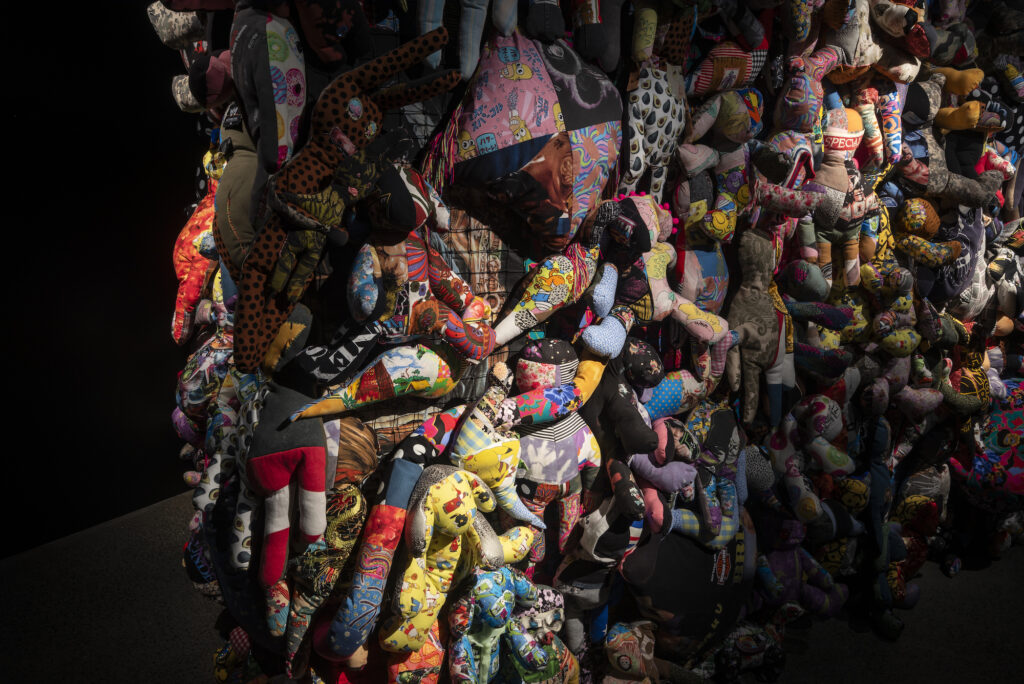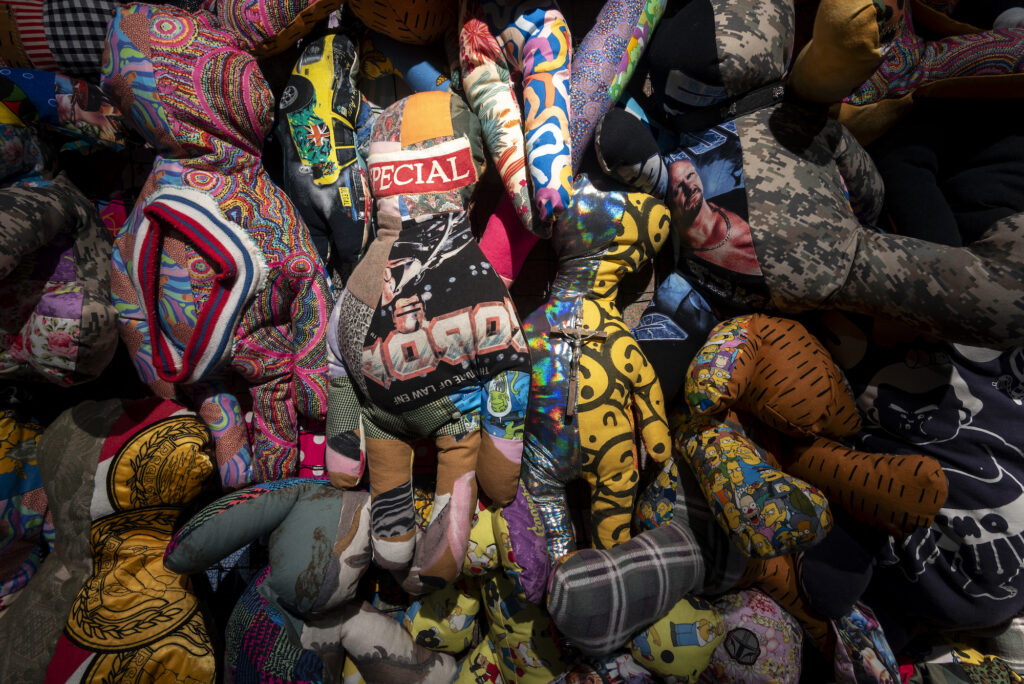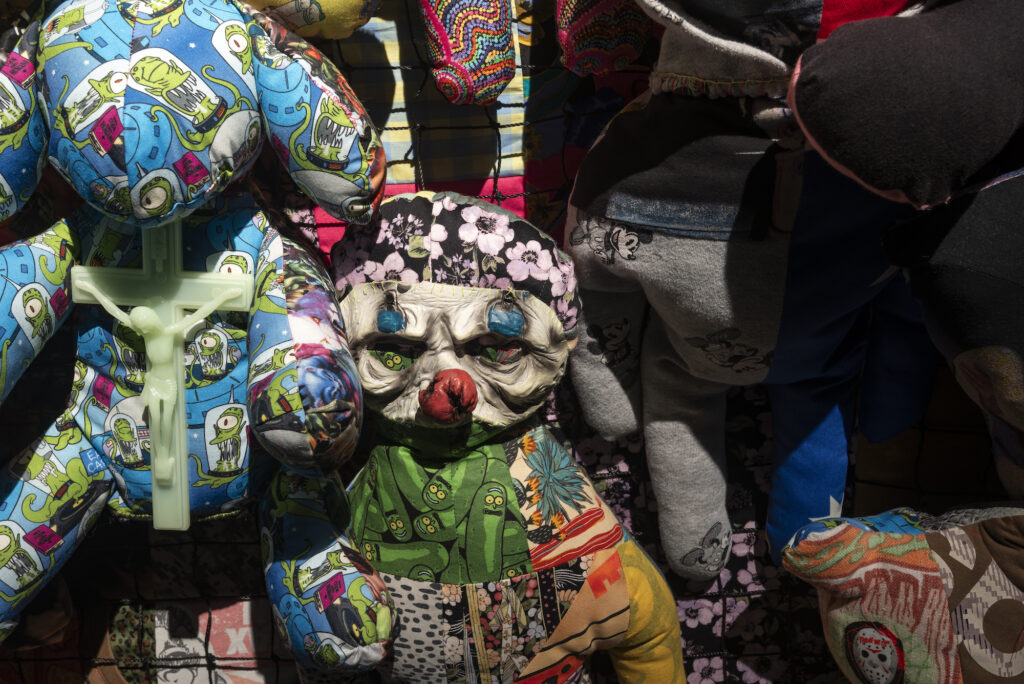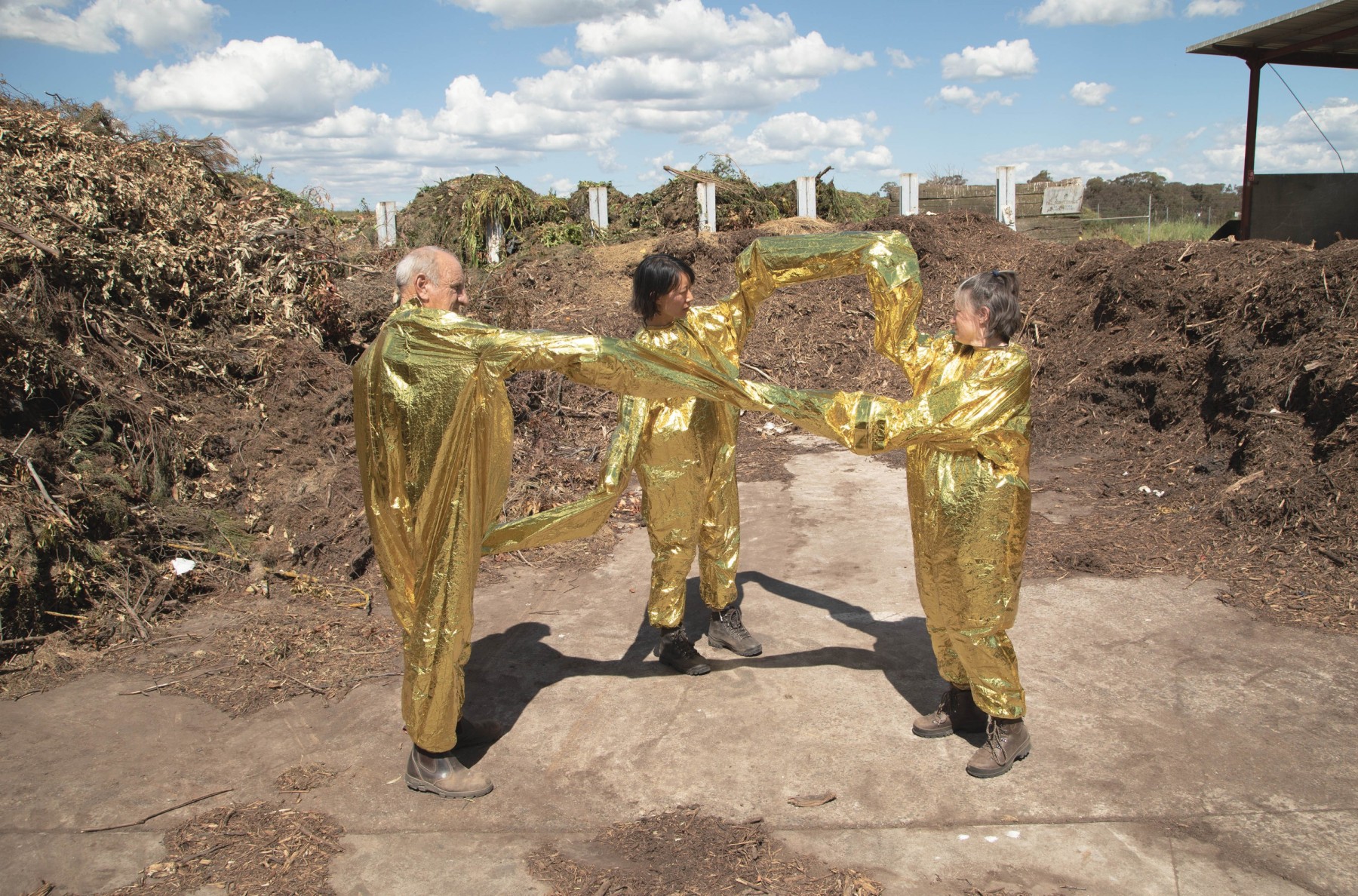
Jeremy Plint’s Monolith quietly confronts viewers with its towering wall of vibrant soft sculptures, reminiscent of childhood toys. Plint has constructed a site-specific installation that, as the title playfully suggests, dominates Metro Arts’ intimate black box space with its monolithic presence.

The makeshift wall structure intentionally divides the room. Its primary face stands tall and parallel with the entrance before the structure angles away from the viewer and tapers down toward the far wall of the room. The imposition of the structure limits movement around the space, creating an immersive experience, just as the lowered height of its side enables visitors to peer over its edge and back toward the entrance, offering a glimpse of the exposed back side of the work’s support frame. Although Monolith would benefit from greater room to appreciate its scale, this considered spatial arrangement makes the most of the challenging space.
The artist has covered the exterior wall surface with enmeshed soft sculptures. Formally trained as a painter, Plint applies the same artistic approach to their textile work, skillfully layering and balancing the colours of the small sculptures within the wall composition. These bright fabric sculptures are tightly packed and overlapping, shaped in teddy bear, rabbit and dinosaur-like forms. Each has received meticulous hand-sewn attention from the artist over an 8-month period, with noticeable stitching and personal details appearing in the finished works. Together, these repeated soft forms generate a looming mass that plays off the bravado of permanent monuments.

The room is also emotionally charged. Plint’s textile prints feature recognisable pop culture references. The likes of The Simpsons, Pokemon, kitsch retro wrestling stars, and Little Miss characters are woven into his three-dimensional collage. By invoking childhood nostalgia, the artist invites a familiar tenderness.
Plint refers to these toy-like sculptures as transitional objects. Within developmental psychology, a transitional object such as a doll, blanket, or other thing chosen by a child, serves as a means of shifting attachment from the primary carer to facilitating engagement with the outside world.1 Plint is not the first to draw from this psychological framework, joining the ranks of artists like Mike Kelley, who has also used childhood artifacts to probe the complexities of innocence and identity.2 However, Plint’s distinction lies in their intimate approach to crafting each transitional object from personally-sourced fabrics, imbuing their work with a profound sense of connection and authenticity that embeds the artist within their social support network.
The past few years have seen a resurgent interest in attachment theory, with hashtags like #attachmentstyles garnering billions of TikTok views and reflecting changing attitudes toward parenting practices.3 Plint’s background in arts therapy enriches their exploration of attachment theory. Their work melds personal experience with clinical insights to challenge conventional narratives of family. As a queer artist and parent, Plint uses handmade forms, imbued with intentional imagery and childhood experiences, to reimagine familial dynamics and legacies of acceptance for their son. For example, Plint’s camp aesthetic, clashing fabrics, and incorporation of WWE wrestling references create space for a new childhood experience that normalises the emergence of queer identities.
Distinct from the overtly sexualised camp aesthetic of textile artists such as Paul Yore, Plint favours subtle references, making their work suitable to viewing by all ages.4 Through costume-like flamboyant fabrics and WWE wrestling idols, Plint further invites viewers to contemplate societal constructs and their impact on the innocence of a child navigating queer identity in their formative years.
A particularly successful and intimate aspect of Plint’s work is their sourcing of fabrics, with approximately 80% of the materials used in this work originating from the artist’s family and community. Handed down or sourced directly from close relatives or friends, these pyjamas, bed sheets, t-shirts, costumes—all fabrics worn or touched by the body—are repurposed to form the skin of Plint’s soft sculptures. By infusing deeply personal experiences into the work, the artist courageously explores their own journey through childhood and parenthood. In a bid to halt the perpetuation of trauma, Plint pioneers a fresh environment that celebrates and nurtures self discovery. This further prompts reflection on the concept of legacy.
Sewing clothes or toys is traditionally perceived as a motherly or feminine domestic duty. By assuming this role as a father, Plint challenges traditional gender roles. Subtle adornments in the form of religious crosses, patches, and recognisable cult symbols are sewn into the work, resonating with structures of worship and reverence. This nuanced incorporation further brings into question systems and structures used to shape one’s identity and concept of culture. The work would benefit from deeper exploration of these nuanced messages and references.

In the dimly lit room, patches of colour reverberate against each other, evoking a feeling more disconcerting than one of comfort and ease. Beneath the seemingly joyful and playful exterior of the work’s soft toys, a sense of trauma resides within the faceless objects, suspended in their function of comfort and care. In physiological practices, dolls serve as vehicles for communicating and embodying physical or emotional harm. In the same sense, Plint evokes the psychological use of these transitional objects as facilitators of the queer experience of childhood, alluding to the psychological harm that can be done without acceptance and care. The hollow interior of the monumental front further underscores the vulnerability of these forms, supported only by a frame—much like the crucial reliance on strong social support systems in early childhood. The exposure of this frame reads at first as unresolved, however it also opens conceptual potential within the work to explore supporting structures.
Monolith prompts viewers to consider the significant responsibility of parenting and the profound influence of a nurturing environment. It reflects on the complexities of bringing a child into a world where, as the artist states, “gender is not binary or imposed, bodies are different and creative self expression is encouraged.”5 The desire for recognition, belonging, and safe connection is palpable in this work. Through each soft form, healing is evident as the artist actively fosters new approaches to parenting and normalising non-traditional family structures. By embracing new media and techniques, Plint facilitates discussion on the queer experience of childhood and fatherhood, underscoring their commitment to queer methodologies with generous vulnerability. Monolith presents a deeply personal and altruistic reflection, serving as a timely reminder of the conscious need to pause, reflect, and cultivate new legacies and behaviours for the next generation.
- Donald Winnicott (no date), Dictionary of Psychology, American Psychological Association. . ↩︎
- “Mike Kelley: The Dark Side of the Toy,” Art Scene Athens, 14 November 2018. ↩︎
- Roe McDermott. “Attachment Theory: What Social Media Gets Badly Wrong about Human Psychology.” The Irish Times, 9 September 2023. ↩︎
- Helen Hughes, “Paul Yore,” Artforum, 1 February 2020. ↩︎
- Jeremy Plint. (2024), Monolith, Exhibition Text, Metro Arts. ↩︎
Ally McKay is a Meanjin/Brisbane based artist, writer and educator. Her creative pursuits are characterised by a keen interest in experimental installation, material poetics, and conceptual explorations of communication.



